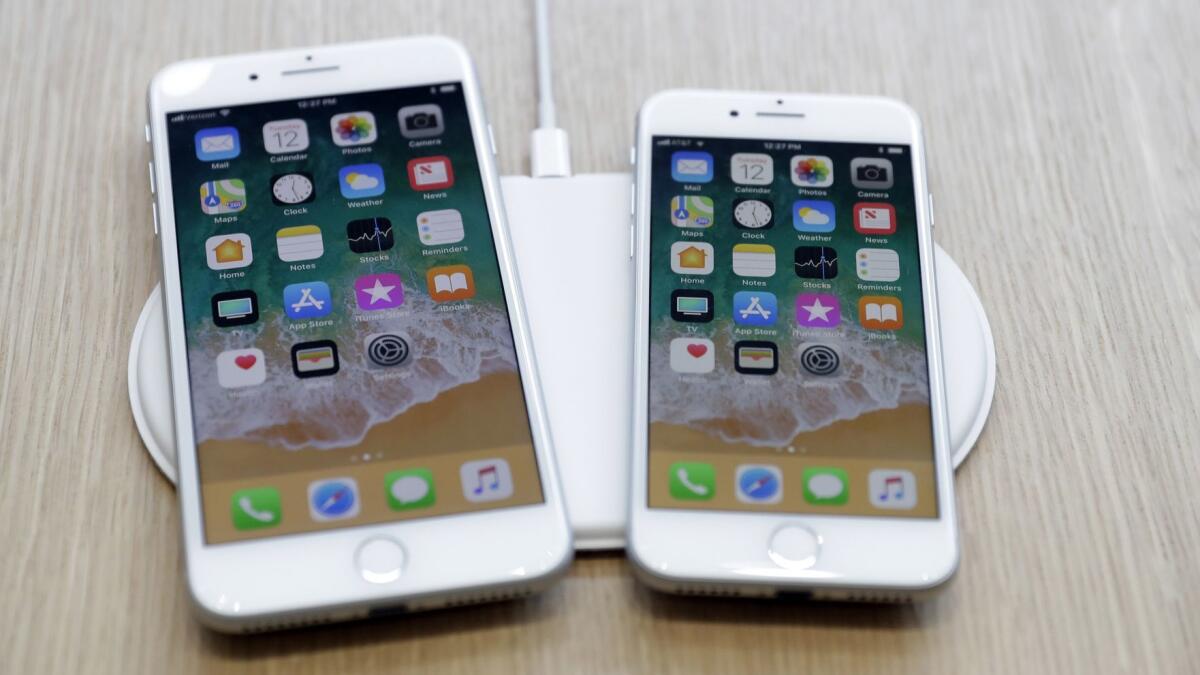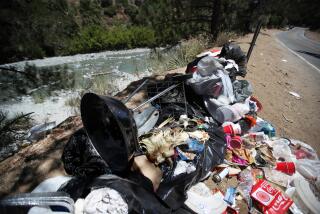The explosive problem with recycling iPads, iPhones and other gadgets: They burst into flames

- Share via
What happens to gadgets when you’re done with them? Too often, they explode.
As we enter new gadget-buying season, spare a moment to meet the people who end up handling your old stuff. Isauro Flores-Hernandez, who takes apart used smartphones and tablets for a living, keeps thick gloves, metal tongs and a red fireproof bin by his desk at Cascade Asset Management, an electronics scrap processor in Madison, Wis. He uses them to whisk away devices with batteries that burst into flames when he opens them for recycling.
One corner of his desk is charred from an Apple iPhone that began smoking and then exploded after he opened it in 2016. Last year, his co-worker had to slide away an exploding iPad battery and evacuate the area while it burned itself out.
Around the world, garbage trucks and recycling centers are going up in flames. The root of the problem: volatile lithium-ion batteries sealed inside our favorite electronics from Apple, Samsung, Microsoft and more. They’re not only dangerous but also difficult to take apart — making recycling e-waste less profitable and contributing to a growing recycling crisis.
These days, rechargeable lithium-ion batteries are in smartphones, tablets, laptops, ear buds, toys, power tools, scooters, hoverboards and e-cigarettes.
For all their benefits at making our devices slim, powerful and easy to recharge, lithium-ion batteries have some big costs. They contain cobalt, often mined in inhumane circumstances in places such as the Democratic Republic of Congo.
And when crushed, punctured, ripped or dropped, lithium-ion batteries can produce what the industry euphemistically calls a thermal event. It happens because these batteries short-circuit when the super-thin separator between their positive and negative parts gets breached. Remember Samsung’s exploding Note 7 smartphone? That was a lithium-ion thermal event.
Old devices end up in trouble when we throw them in the trash, stick them in the recycling bin or even responsibly bring them to an e-waste center. There isn’t official data on these fires, but the anecdotal evidence is stark. Since the spring of 2018 alone, batteries have been suspected as the cause of recycling fires in New York, Arizona, Florida, Wisconsin, Indiana, Idaho, Scotland, Australia and New Zealand. In California, a recent survey of waste management facilities found 83% had at least one fire over the last two years, of which 40% were caused by lithium-ion batteries.
Statistically, the fire rates are low — one out of 3,000 mobile device batteries that Cascade handles experiences a thermal event. But when batteries spark other material, the result can be catastrophic. In 2016, the Shoreway Environmental Center that serves Silicon Valley suffered a four-alarm fire it suspects was caused by a lithium-ion battery that ignited undetected amid other junk in its sorting systems. The fire damage cost $8.5 million.
There’s plenty of blame to go around. People shouldn’t carelessly throw battery-powered electronics into the trash bin. Local governments haven’t figured out good ways for us to hand off of this common but dangerous material. The tech press (including me) should write less about shiny new things and more about how to make old stuff last longer. Some gadget makers, including Apple, are taking steps to make recycling easier.
Ultimately, however, this is an environmental problem of the tech industry’s own design. And the industry should own it.
It’s bad enough that lithium-ion batteries are dangerous. But often, gadgets designed to be thin and portable make the batteries especially difficult to remove.
To see it like a recycler, I spent a day with Flores-Hernandez at Cascade, the e-waste company in Wisconsin. It takes in all kinds of electronics from businesses that pay it to wipe data and recycle — some 257,000 items last year. When it can, Cascade refurbishes devices or harvests valuable parts. When stuff is too old, Cascade pulls it apart and tries to salvage commodities.
That’s easier said than done with some of our favorite mobile devices. Out of his stack of used tablets, Flores-Hernandez shows me a 6-year-old iPad with a shattered screen. Before it could be sent to a shredder, which separates the materials that can be melted down, he has to get the battery out by hand.
I should have taken a seat — the process took 40 minutes. To get to the battery, first Flores-Hernandez has to remove the electronics on top of it. He puts the iPad on a 100-degree heating plate for about four minutes to loosen glue that adheres the screen. Then off come broken glass, the screen and dozens of tiny screws.
There’s no indication Apple products are more likely to catch fire than other devices (though Cascade says they’ve been the source of all its fires since 2015). But iPads are more difficult to take apart. “On a scale of 1 to 10, I would say this is an 8 or 9,” Flores-Hernandez said.
He learned how to do this through a training program from iFixit, an online repair community. Apple and many other manufacturers don’t provide instructions or analysis software to recyclers such as Cascade. Handling this stuff is tricky even for its makers: Apple stores in Switzerland, Spain and the Netherlands have all experienced battery fires in 2018.
About 30 minutes into iPad surgery comes the most delicate part: prying out the battery glued to the back of the iPad. After heating the iPad again to loosen glue, he uses a series of plastic squeegees to nudge out the battery — as flat as a plastic comb and almost as wide as the iPad — bit by bit.
“Don’t bend it. Don’t poke it. Just try to go slow,” Flores-Hernandez says, explaining his tactics.
I hold my breath. The iPad doesn’t explode. This time.
Smaller gadgets with lithium-ion batteries such as vape pens and headphones are more difficult to detect in a pile of waste, and they can be even harder to disassemble. IFixit has deemed Apple’s wireless AirPods, for one, all but impossible to recycle because they contain three batteries, each sealed inside plastic.
It’s more than just a safety issue, said Cascade Chief Executive Neil Peters-Michaud. Gluing components together and hiding the batteries also makes recycling less profitable. For the training, safety precautions and effort that went into removing that iPad battery, Cascade will make about 50 cents to $1 in commodities. “Labor and time are money,” Peters-Michaud said.
“I just don’t understand why Apple doesn’t include design features that its users and the reuse-and-recycling community can benefit from to extend the life of their products safely,” he said.
The risk is that devices such as old iPads could become unrecyclable, at least in economic terms, for scrap companies that aren’t getting paid some other way. Today, companies can still make money by reselling iPads. But who’s going to process all the old iPads marooned in drawers, losing their market value?
“We are reaching the pivot point that it is a more costly process to separate the materials than the value of the materials that can be recovered,” said Craig Boswell, co-founder of HOBI International, an e-waste company with locations in Arizona, Illinois and Texas. “That applies not only to the iPad, but most of the designs that have internally sealed batteries.”
Gadgets don’t have to be designed this way. In 2014, Samsung’s flagship Galaxy S5 smartphone had a rechargeable battery that could be easily removed. My old PalmPilot used two AAA alkaline batteries that just pop out. Removable batteries could have helped Apple avoid the debacle in which it got caught slowing iPhones with worn-out batteries — and then had to offer discounted battery replacements to get back in our good graces.
The sealed approach makes electronics thinner, which the companies say we want; removable batteries require additional shielding that takes up space. Sealing in a battery with a lifespan of just a few years is also a way to force customers to upgrade, though tech giants have said they’re not baking planned obsolescence into their designs.
Apple wouldn’t answer my questions on its practices.
Apple, which does more for concerns such as clean energy and hazardous chemicals than most other big tech firms, is hardly alone in designing products with recycling challenges.
Last year, Greenpeace graded companies for their overall environmental impact. That included a grade for “product life extension,” a measure of how products are designed to be taken apart for repair, reuse and recycling. Most firms, including Apple, Microsoft and Samsung, got Ds in that category.
They could take a lesson from HP, awarded an A by Greenpeace for product life extension. It makes products that are easily upgraded and taken apart (including laptops and tablets with replaceable batteries) and it shares repair and disassembly instructions widely.
“Designing for repair makes a huge difference in the life cycle impact of the product,” said Gary Cook, a senior corporate campaigner at Greenpeace. Some tech companies, including Apple, have actively opposed “right to repair” legislation that would require companies to share information on how to take apart products.
Apple has made some public commitments on recycling. It offers a take-back program, where it pays for products to be properly recycled at facilities it vets. Apple hasn’t disclosed how much of the material it creates that it takes back, but other recyclers tell me it’s probably just a fraction. An industry-funded program called Call2Recycle collected 2.7 million pounds of lithium-ion batteries last year. It said that represents a “single-digit percentage” of all the ones sold in the United States.
Last year, Apple said it was working toward a “closed-loop” supply chain for its products, in which it will someday make products out of recycled or renewable materials only. It has also been working on robots that can recycle some of its products more quickly and safely than humans. Its latest, called Daisy, can disassemble 200 iPhones in an hour.
So far, there’s only one Daisy robot (with a second in the works), and Apple hasn’t said how many iPhones Daisy has recycled. Recycling companies that handle thousands of kinds of electronics say they’re skeptical they’d reap much benefit from a robot that takes apart only one kind of thing.
Most people I spoke to in the recycling industry agree there’s a better fix: Go back to removable batteries.
“You can have very elegant design and high-energy density,” said Carl Smith, the CEO of Call2Recycle. “I don’t think those are two totally independent notions.”
So as a gadget reviewer, let me say this clearly to the tech industry: Give up your thin obsession. We’ll happily take electronics with a little extra junk in the trunk if it means we can easily replace batteries to make them last longer — and feel more confident they won’t end up igniting a recycling inferno.
Geoffrey A. Fowler writes for the Washington Post.
Fowler writes for the Washington Post.






